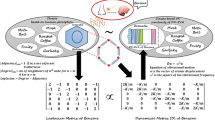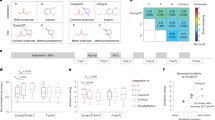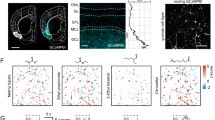Abstract
Olfaction exhibits both high sensitivity for odours and high discrimination between them1. We suggest that to make fine discriminations between complex odorant mixtures containing varying ratios of odorants without the necessity for highly specialized peripheral receptors, the olfactory systems makes use of feature detection using broadly tuned receptor cells organized in a convergent neurone pathway. As a test of this hypothesis we have constructed an electronic nose using semiconductor transducers and incorporating design features suggested by our proposal. We report here that this device can reproducibly discriminate between a wide variety of odours, and its properties show that discrimination in an olfactory system could be achieved without the use of highly specific receptors.
This is a preview of subscription content, access via your institution
Access options
Subscribe to this journal
Receive 51 print issues and online access
$199.00 per year
only $3.90 per issue
Buy this article
- Purchase on Springer Link
- Instant access to full article PDF
Prices may be subject to local taxes which are calculated during checkout
Similar content being viewed by others
References
Stoddart, D. M. (ed.) Symp. zool. Soc., Lond. 45, (1980).
Dodd, G. H. & Squirrell, D. J. Symp. Zool. Soc., Lond. 45, 35–56 (1980).
Dodd, G. H. & Persaud, K. in Biochemistry of Taste and Olfaction (eds Cagan, R. & Kare, M.) 333–357 (Academic, New York, 1981).
Holden, A. V. Lect. Notes Biomath. 32 (Springer, Heidelberg, 1976).
Sampson, J. R. Adaptive Information Processing (Springer, Berlin, 1976).
Uttal, W. R. The Psychobiology of Sensory Coding (Harper & Row, New York, 1973).
Deutsch, S. Models of the Nervous System (Wiley, New York, 1967).
Cherry, R. J., Dodd, G. H. & Chapman, D. Biochim. biophys. Acta 211, 409–416 (1970).
Wilkens, W. F., Hartman, J. D. & Rosano, H. Ann. N.Y. Acad. Sci. 116, 608–612 (1964).
Moncrieff, R. W. J. appl. Physiol. 16, 742–749 (1961).
Dravnieks, A. & Trotter, P. J. J. Scient. Instrum. 42, 624–627 (1965).
Sawateri, K. Chem. Abstr. 83, P 35757 T (1975).
Tanyolac, N. N. & Eaton, J. R. J. Am. pharmac. Ass. 39, 10–14 (1950).
Persaud, K., Pelosi, P. & Dodd, G. H. Olfaction & Taste 7, 101 (1980).
Ohno, Y. Chem. Abstr. 85, 28276Y (1976).
T.G.S. Gas-Sensing Semi-Conductor (Figaro Engineering Inc., Osaka, 1974).
Dodd, G. H. & Persaud, K. C. Provisional UK Patent No. 8035806 (1980).
Electronics Today International 62–65 (January 1979).
Roberts, G. G., Pande, K. P. & Barlow, W. A. Electron. Lett. 13, 581–583 (1977).
Persaud, K., Wood, P., Squirrell, D. J. & Dodd, G. H. Biochem. Soc. Trans. 9, 107–108 (1981).
Menevse, A., Dodd, G. H. & Poynder, T. M. Biochem. J. 176, 845–854 (1978).
Squirrell, D. J. thesis, Univ. Warwick, UK (1978).
Author information
Authors and Affiliations
Rights and permissions
About this article
Cite this article
Persaud, K., Dodd, G. Analysis of discrimination mechanisms in the mammalian olfactory system using a model nose. Nature 299, 352–355 (1982). https://doi.org/10.1038/299352a0
Received:
Accepted:
Issue Date:
DOI: https://doi.org/10.1038/299352a0
This article is cited by
-
Data-centric artificial olfactory system based on the eigengraph
Nature Communications (2024)
-
Biomimetic olfactory chips based on large-scale monolithically integrated nanotube sensor arrays
Nature Electronics (2024)
-
Smelling the Disease: Diagnostic Potential of Breath Analysis
Molecular Diagnosis & Therapy (2023)
Comments
By submitting a comment you agree to abide by our Terms and Community Guidelines. If you find something abusive or that does not comply with our terms or guidelines please flag it as inappropriate.



